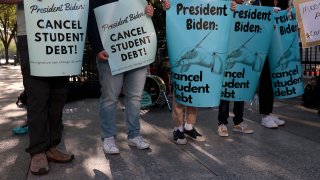
- Federal student loans are far from the only debt burdening American families.
- Household debt, include the balances on credit cards and mortgages, exceeds $15 trillion.
- But there are some meaningful reasons explaining why there's been such a strong, unified and widening movement to get education debt, in particular, wiped out.
Throughout the conversation around student loan forgiveness, one frequently asked question is why cancel education debt, and not, say, credit card debt or mortgages?
What's so different about student loans?
In some ways, nothing. People borrow for their education for the same reasons they borrow for anything else — they can't afford the item or service on their own.
Get Southern California news, weather forecasts and entertainment stories to your inbox. Sign up for NBC LA newsletters.
But there are some meaningful reasons that explain why there's been such a strong, unified and widening movement to get student loans canceled. Here are four of them, according to experts.
1. The system is 'broken'
Even before the pandemic, and when the economy was booming, repayment troubles were common among federal student loan borrowers.
Money Report
The country's outstanding education debt balance exceeded $1.7 trillion and posed a larger burden to households than credit card or auto debt. Roughly a quarter of loan holders — or 10 million people — were estimated to be in delinquency or default.
About a fifth of federal student loan borrowers attended for-profit colleges, many of which have come under fire for misleading students and failing to provide them with a quality education. Half of students who leave these schools end up defaulting on their loans.
The U.S. Department of Education has also not made good on many of its promises, said Persis Yu, policy director for the Student Borrower Protection Center.
More from Personal Finance:
Here's how to buy new work clothes on a budget
These are the best and worst U.S. places to die
Be sure to manage this risk as you near retirement
Millions of people enrolled in programs that are supposed to lead to debt forgiveness after a certain period of time, including income-driven repayment plans and the popular public service loan forgiveness program, have been stuck continuing to pay and rejected for the relief, often for technical and confusing reasons.
The companies that service federal student loans have been accused of giving borrowers wrong and incomplete information.
"There have been decades of mismanagement, abusive practices and general incompetence, which has resulted in millions of borrowers missing out on many of the vital programs and benefits afforded under the law," Yu said.
2. Most loans won't be repaid anyway
One of the arguments for forgiving student loans is that millions of borrowers will never pay off their debt anyway. In the meantime, they face a host of consequences from having tens of thousands of dollars on their personal balance sheets, including difficulty buying a house and starting a business.
According to a rough estimate by higher education expert Mark Kantrowitz, prior to the pandemic, just about half of federal student loan borrowers, or 20 million people, were in repayment — the rest were in deferments or forbearances or had stopped paying their loans altogether.
3. There's (basically) one creditor
Federal student debt is far from the only debt burdening American families. Household debt, including the balances on credit cards and mortgages, exceeds $15 trillion.
Canceling any other type of debt other than federal student loans, however, would be much more logistically and financially tricky. Hundreds of banks underwrite credit cards and auto loans, whereas it's mostly just one party — the U.S. government — that owns federal student debt.
With the pain of inflation hitting families and fear that a recession could be on the horizon, advocates point to student loan forgiveness as a relatively easy way for President Joe Biden to deliver relief to the country, especially after most of his social spending agenda has been derailed by Congress.
"Unlike debts held by private creditors, the president has the authority to eliminate federal student loan debt with the stroke of a pen," Yu said.
4. Education is a public good
While credit card debt, auto loans and home mortgages are mainly a private benefit, "a higher education is part of the fabric of society, with both a public and private benefit," Kantrowitz said.
College graduates pay more than twice the federal income tax of high school graduates, he added. "It's not just a good investment for the federal government — there's no better investment."
Those who graduate college also have lower unemployment rates and are less likely to need public benefits such as Medicaid and food stamps, Kantrowitz added, "reducing the burden on society." They also vote and volunteer at higher levels than those without a bachelor's degree.
Still, tuition at colleges has skyrocketed over time, while state aid and grants have declined. As a result, the cost of higher education has increasingly been put on families.
The average loan balance at graduation has tripled to $30,000 from $10,000 in the 1990s. Around 7% of student loan borrowers owe more than $100,000.
"It really comes down to this idea that debt-free college is a public good, and just as we think about K-12 education as serving the public interest, the health of our economy and the health of our democracy, so, too, should we think about higher education," former Education Secretary John King told CNBC recently.






